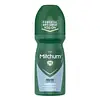What's inside
What's inside
 Key Ingredients
Key Ingredients

 Benefits
Benefits

No benefits
 Concerns
Concerns

 Ingredients Side-by-side
Ingredients Side-by-side

Cyclopentasiloxane
EmollientAluminum Zirconium Tetrachlorohydrex Gly
AstringentStearyl Alcohol
EmollientC12-15 Alkyl Benzoate
AntimicrobialHydrogenated Castor Oil
EmollientDimethicone
EmollientTalc
AbrasiveParfum
MaskingPEG-8 Distearate
EmulsifyingTocopheryl Acetate
AntioxidantAloe Barbadensis Leaf Extract
EmollientHydrogen Peroxide
AntimicrobialSilica
AbrasiveDimethicone Silylate
Laureth-23
CleansingSodium Starch Octenylsuccinate
AbsorbentBenzyl Salicylate
PerfumingLimonene
PerfumingLinalool
PerfumingHexyl Cinnamal
PerfumingCoumarin
PerfumingCitronellol
PerfumingGeraniol
PerfumingCinnamyl Alcohol
PerfumingCitral
PerfumingCyclopentasiloxane, Aluminum Zirconium Tetrachlorohydrex Gly, Stearyl Alcohol, C12-15 Alkyl Benzoate, Hydrogenated Castor Oil, Dimethicone, Talc, Parfum, PEG-8 Distearate, Tocopheryl Acetate, Aloe Barbadensis Leaf Extract, Hydrogen Peroxide, Silica, Dimethicone Silylate, Laureth-23, Sodium Starch Octenylsuccinate, Benzyl Salicylate, Limonene, Linalool, Hexyl Cinnamal, Coumarin, Citronellol, Geraniol, Cinnamyl Alcohol, Citral
Ingredients Explained
These ingredients are found in both products.
Ingredients higher up in an ingredient list are typically present in a larger amount.
We don't have a description for Aluminum Zirconium Tetrachlorohydrex Gly yet.
Laureth-23 is created by reacting ethylene oxide with Lauryl Alcohol.
It is a cleansing ingredient. This means it helps lift oils and dirt so they may be rinsed away with water.
The 23 refers to the number of repeating ethylene oxides in the molecule.
Learn more about Laureth-23Parfum is a catch-all term for an ingredient or more that is used to give a scent to products.
Also called "fragrance", this ingredient can be a blend of hundreds of chemicals or plant oils. This means every product with "fragrance" or "parfum" in the ingredients list is a different mixture.
For instance, Habanolide is a proprietary trade name for a specific aroma chemical. When used as a fragrance ingredient in cosmetics, most aroma chemicals fall under the broad labeling category of “FRAGRANCE” or “PARFUM” according to EU and US regulations.
The term 'parfum' or 'fragrance' is not regulated in many countries. In many cases, it is up to the brand to define this term.
For instance, many brands choose to label themselves as "fragrance-free" because they are not using synthetic fragrances. However, their products may still contain ingredients such as essential oils that are considered a fragrance by INCI standards.
One example is Calendula flower extract. Calendula is an essential oil that still imparts a scent or 'fragrance'.
Depending on the blend, the ingredients in the mixture can cause allergies and sensitivities on the skin. Some ingredients that are known EU allergens include linalool and citronellol.
Parfum can also be used to mask or cover an unpleasant scent.
The bottom line is: not all fragrances/parfum/ingredients are created equally. If you are worried about fragrances, we recommend taking a closer look at an ingredient. And of course, we always recommend speaking with a professional.
Learn more about ParfumTocopheryl Acetate is AKA Vitamin E. It is an antioxidant and protects your skin from free radicals. Free radicals damage the skin by breaking down collagen.
One study found using Tocopheryl Acetate with Vitamin C decreased the number of sunburned cells.
Tocopheryl Acetate is commonly found in both skincare and dietary supplements.
Learn more about Tocopheryl Acetate